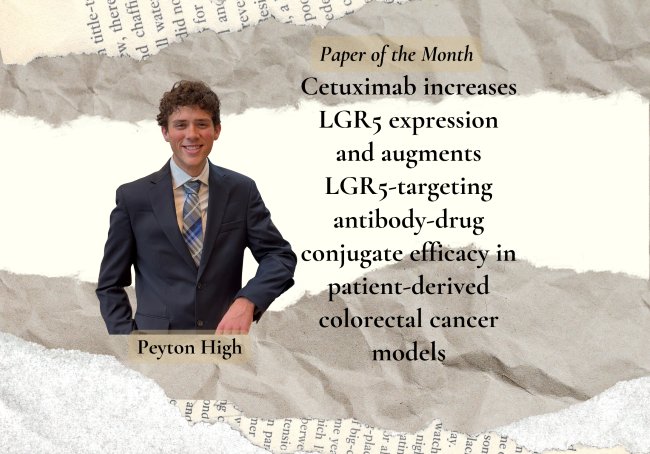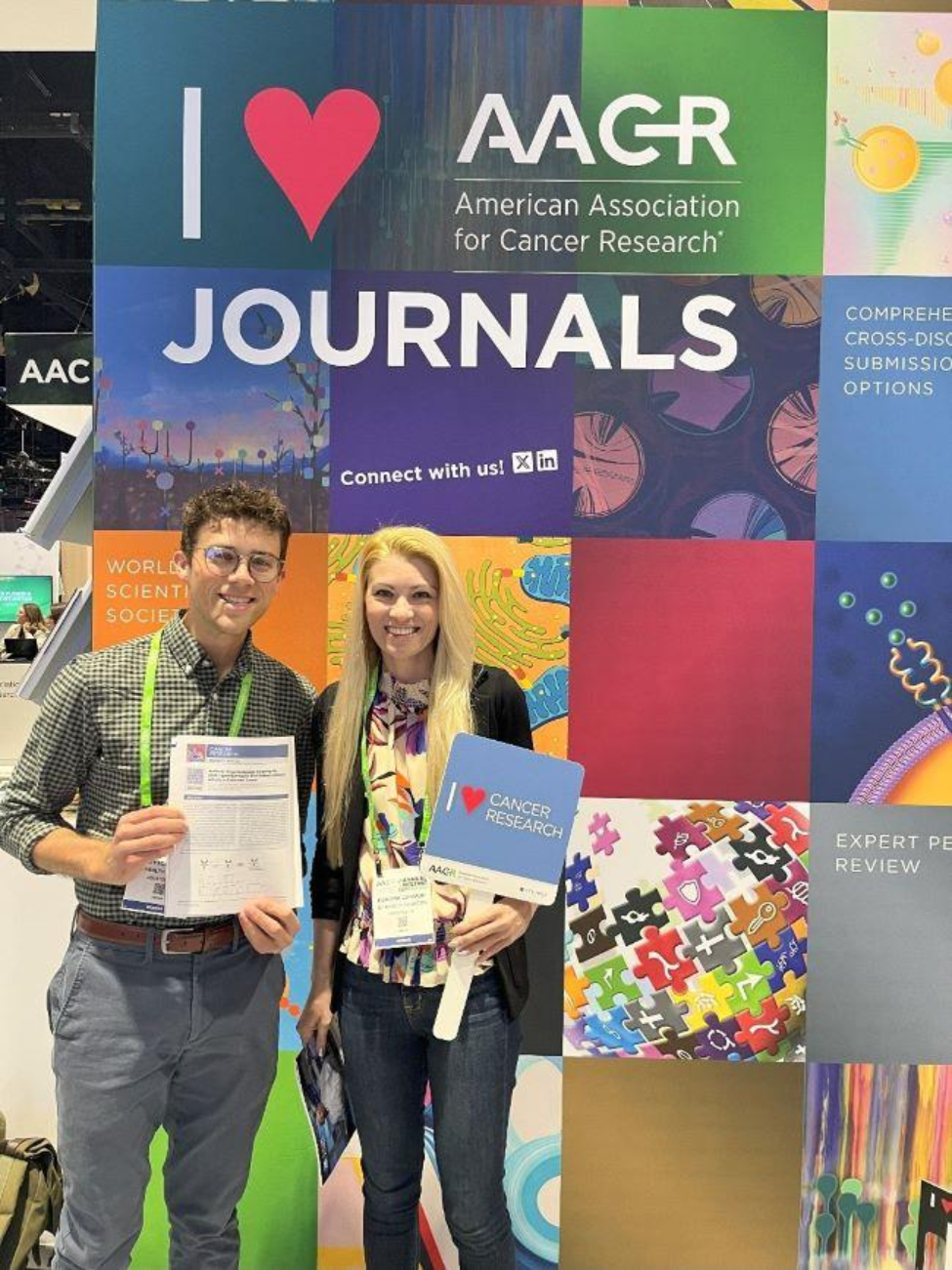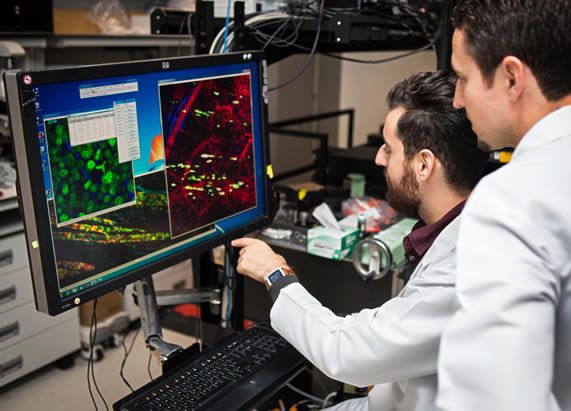September’s Paper of the Month explores a novel combination therapy with one goal: overcoming toxicity and resistance in colorectal cancer
September 24, 2025 By: Amanda Warner/Graduate Student/Cancer Biology Program/The University of Texas MD Anderson Cancer Center UTHealth Houston Graduate School of Biomedical Sciences



Paper of the Month: Cetuximab increases LGR5 expression and augments LGR5-targeting antibody-drug conjugate efficacy in patient-derived colorectal cancer models
Finding a drug target for cancer is a tricky business given that cancer cells often express many of the same markers as healthy cells. If a therapeutic target is chosen that is expressed on both cancer and healthy cells, excess toxicity is often observed, forcing treatment discontinuation. Unfortunately, once an acceptable cancer-specific target is found, drug resistance often occurs. Drug resistance can occur via many different mechanisms, such as loss of target expression or acquired genetic mutations that render the drug inefficient.
So how can the challenges of drug toxicity and resistance be overcome? That is exactly what Molecular and Translational Biology Program PhD student Peyton High and his mentor, Kendra Carmon PhD, sought to answer for colorectal cancer (CRC). In their recent article with student and faculty co-authors in Cell Reports Medicine, two different types of therapies were strategically used in combination to kill CRC cells, limit resistance, and decrease toxicity.
CRC is the second leading cause of cancer-related deaths in the United States (American Cancer Society). While CRC cells express many different markers, the surface protein leucine-rich repeat-containing G protein-coupled receptor 5 (LGR5) represents an emergent preclinical and clinical-stage target for therapeutic development. Specifically, LGR5 is expressed on CRC stem-like cells which are an attractive target given that these cells are necessary for CRC tumor growth and metastatic outgrowth.
Therapies that target LGR5, such as LGR5-targeting antibody-drug conjugates (ADCs), have previously been developed by Carmon’s group and others. ADCs consist of an antibody and a highly potent drug payload that are tethered together by a chemical linker. ADCs function like a biological missile where the antibody serves as the ‘sensor’ to recognize the target of interest, such as LGR5, and the drug payload serves as the ‘warhead’ to destroy the cancer cell. By targeting cancer-specific antigens, such as LGR5, ADCs restrict the delivery of potent payloads to cancer cells, while sparing normal tissues.
LGR5 ADCs with unique linkers and payloads have been successful in pre-clinical models; however, sometimes relapse or excess toxicity occurs. “Expanding evidence indicates that their [ADC] efficacy as monotherapies is limited by drug resistance and toxicity,” High explains.
“Combination treatments have therefore emerged as one strategy to mitigate ADC toxicity and counteract drug resistance.”
To combat this problem, High set out to develop a new LGR5 ADC with an altered treatment regimen that would improve efficacy, decrease toxicity, and prevent tumor relapse. He describes, “we hypothesized that a multi-targeting treatment strategy, that which eliminates LGR5+ and LGR5- cells within a tumor, may prove more effective than LGR5 ADCs alone.”
The search for an additional target
To narrow down the search for another target beyond LGR5, the authors turned to previous literature. Epidermal growth factor receptor (EGFR) is overexpressed on 60-80% of CRC cells and has been commonly targeted in various cancers, including CRC. EGFR canonically activates downstream proteins, like RAS and PI3K, to promote cell proliferation. Curiously, cetuximab, an FDA-approved monoclonal antibody against EGFR, was previously shown to increase LGR5 gene expression via an unknown mechanism. Given the possibility that upregulated LGR5 expression through cetuximab may confer improved LGR5 ADC efficacy, High and Carmon decided to investigate if adding cetuximab to the LGR5 ADC regimen would lead to improved outcomes as compared to either treatment alone.
Before testing this combination therapy, cetuximab first had to be tested for its effect on LGR5 levels in a panel of human CRC cells, either with wild-type or mutant RAS and/or PIK3CA. This is important since RAS and PIK3CA are commonly mutated in CRC and can confer resistance to EGFR targeting by cetuximab. As expected, CRC cells treated with cetuximab had increased LGR5 gene and protein expression. However, this change was seen in both the wild-type and mutant RAS and PIK3CA cell lines, which was an unexpected result.
The authors then further investigated the interactions between EGFR signaling and LGR5 expression as this was unclear in the literature. Intriguingly, loss of EGFR led to a decrease in LGR5 in CRC cells. The same finding of diminished LGR5 expression was observed when the CRC cells were exposed to the EGFR ligand EGF, which made sense, as EGF is known to degrade EGFR. Moreover, High demonstrated a novel finding that LGR5 and EGFR interact directly with each other, and that this interaction was enhanced in the presence of cetuximab. These results give insight into the possible mechanisms governing EGFR signaling and LGR5 expression.
Putting the pieces together: Engineering a new ADC and testing a combinational therapy
Since cetuximab enhanced LGR5 expression in CRC cells, it was then time to develop a new LGR5 ADC with limited toxicity and enhanced efficacy as compared to previously developed LGR5 ADCs. “My favorite aspect of performing this work was developing a novel LGR5-targeting ADC,” High reflected.
“Developing cancer therapeutics has been a lifelong dream of mine and I feel incredibly grateful to be able to do so during my PhD.”
The LGR5 ADC was elegantly developed through a series of biochemistry assays and contains a camptothecin-derived payload with a tripeptide linker. This payload and linker combination was chosen due to its enhanced stability and efficacy as compared to traditional ADC linker-payload combinations.
The new LGR5 ADC, named 8E11-CPT2, was then tested for its target specificity. 8E11-CPT2 selectively targeted and killed LGR5+ cell lines with high potency while LGR5- cells were minimally affected. When multiple CRC cell lines were treated with both 8E11-CPT2 and cetuximab, this combination therapy had a synergistic effect, independent of the cell line RAS mutation status. This suggests that the increase in LGR5 expression by cetuximab augments the efficacy of the LGR5 ADC.
Given these exciting in vitro results, the combination treatment, along with single agent controls, were tested for tolerability and efficacy in pre-clinical models. First, increasing doses of 8E11-CPT2 were tested to assess any potential toxicities. Importantly, all tested doses were found to be safe with no observable toxicities. Similar to the results from cell lines, cetuximab treatment resulted in upregulated LGR5 expression in two different pre-clinical models, confirming that this mechanism holds true in vivo.
The combination of 8E11-CPT2 and cetuximab resulted in a striking decrease in tumor growth and enhanced survival as compared to either treatment alone in two RAS mutant, patient-derived pre-clinical models. Ultimately, these results confirmed High’s original hypothesis that a multi-targeting treatment regimen with LGR5 ADCs is indeed more efficacious in treating CRC.
What is in store for the future of this combination therapy?
Beyond the valuable finding that cetuximab improves LGR5 ADC efficacy in CRC, these results have even further clinical implications. “While cetuximab is [currently] exclusively approved for RAS wildtype CRCs, our study demonstrates enhanced efficacy of LGR5 ADCs in combination with cetuximab in CRC models harboring RAS mutations,” states High. Therefore, the findings of this study may expand the treatment landscape for CRC since cetuximab is effective against both wild-type and mutant RAS-driven CRC when dosed in combination with an LGR5-targeting ADC. Since RAS-mutant CRC has historically been difficult to effectively treat, this is good news for the development of new CRC therapies.
Following the success of the LGR5 ADC and cetuximab combinatorial treatment in CRC pre-clinical models, the authors of this study plan to continue to improve the efficacy of the treatment regimen in a way that will further prevent relapse and toxicity. “We are now evaluating alternative dosing strategies and developing other dual-targeting modalities, such as EGFR:LGR5 bispecific ADCs, to evaluate against the combination treatments that we describe in this work,” High says.
While the therapeutic implications of this work are tremendous, it is important to not forget about the mechanistic work that was addressed in this paper. These basic science studies are essential for driving the development of new therapies. High shares that “the mechanism by which EGFR inhibition upregulates LGR5 expression…remains unclear and warrants further investigation.” This work will serve as a foundation for future studies to unravel the possible regulation of LGR5 by EGFR and potential shared downstream signaling pathways.
Overall, High’s research demonstrates a novel interaction between LGR5 and EGFR where targeting both these CRC markers in combination results in improved outcomes in pre-clinical models. His work expounds upon the current theories in the field that strategic multi-target treatments will be less toxic and more efficacious in limiting CRC tumor growth compared to single agents alone.
In addition to the achievement of his first-author paper in Cell Reports Medicine, High has shown outstanding academic excellence early in his graduate career as he received six oral presentation awards and three poster awards, was awarded four fellowships including the TIPS T32 and Dr. John J. Kopchick fellowships, and was an invited speaker at both the Salk Institute and the Moffitt Cancer Center symposiums earlier this year. His dedication to and passion for therapeutic drug development in CRC will surely be a story to follow.
Paper of the Month (POM) is a collaborative effort led by Microbiology and Infectious Diseases PhD candidate Jana Gomez and Communications Manager Shelli Manning, and overseen by Associate Dean for Academic Affairs Francesca Cole, PhD, who work with students to summarize fellow student-authored scientific articles about their biomedical science research and the innovative methods and discoveries they are uncovering. The POM editorial team includes students Shraddha Subramanian, Mirrah Bashir, Amanda Warner (author of September’s POM summary), Chae Yun Cho, Altai Enkhbayar, Zarmeen Khan, Archit Gupta, and Sheighlah McManus.







